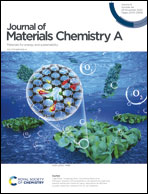Rational design of a highly mesoporous Fe–N–C/Fe3C/C–S–C nanohybrid with dense active sites for superb electrocatalysis of oxygen reduction†
Abstract
Innovating efficient and robust electrocatalysts with economical production cost for the oxygen reduction reaction (ORR) is of utmost significance for enhancing the energy efficiency of fuel cells and metal–air batteries. Herein, a single-step doping/annealing strategy has been developed for fabricating an Fe–N–C/Fe3C/C–S–C nanohybrid with a high N-doping level, well-defined mesoporous/microporous architecture, and high density of efficient active sites. The importance of tuning the S-doping into the electrocatalyst carbon framework has been fully elaborated for the first time. Under alkaline conditions, the nanohybrid displayed an exceptional onset potential (E0) and half-wave potential (E1/2) of 1.078 and 0.929 V vs. reversible hydrogen electrode (RHE). Furthermore, it manifests a dominant four-electron transfer reaction, marvelous selectivity for the ORR in the presence of methanol, and excellent durability after 15 000 potential cycles with almost zero degradation in performance under both acidic and alkaline conditions. The superb performance is due to the high density of active sites, like FeNx, FeSx, Fe3C, pyridinic-N, graphitic-N, C–S–C, and C–SOx–C, that efficiently catalyze the ORR. In addition, the high graphitization degree boosts the electron conductivity and corrosion resistance; meanwhile, the high surface area and ideal mesoporosity enhance the mass transfer and facilitate the maximum exposure of the active sites to the electrolyte and reactants.



 Please wait while we load your content...
Please wait while we load your content...